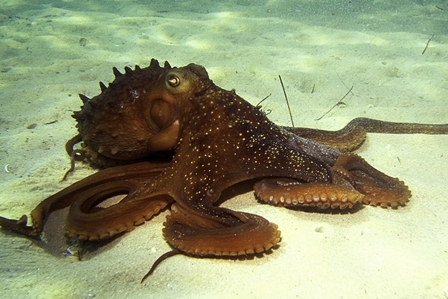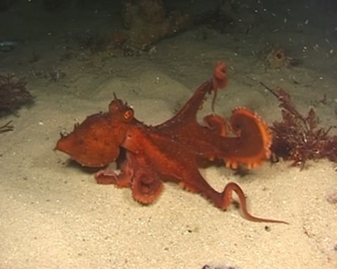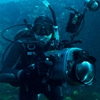General Description
Large muscular octopus (Australia's largest). Body oval-shaped, eyes large. Arms long and muscular, the front pair being the longest and broadest. Colour dark orange-brown scattered with numerous small white spots. Skin covered in scattered large, unbranched fingers of skin (papillae) forming a spiky appearance in some postures. Maximum mantle length 30 cm, total length to around 1 m, weight to around 10 kg.
Biology
This octopus forms lairs in crevices or burrows, recognised by the scatter of shells and crab parts around the entrance. Larger animals often sit within the mouth of the lair. Smaller animals are generally night active while larger animals can be active during both the day and night. This octopus feeds on a wide range of prey including crabs, abalone, crayfish, mussels, fish and other octopuses. The deep webs can be flared to trap prey. Day-foraging animals are often accompanied by wrasses that grab any prey that escape the octopus' clutches. Mating occurs by the male engulfing the female within his webs and inserting the modified third right arm into her gill cavity to place sperm packets in her oviducts. The females lay strings of small eggs, attaching them to hard surfaces such as in rock crevices. The young hatch as planktonic young that travel in ocean currents between Australia and New Zealand. This octopus is harvested in both targeted fisheries and as bycatch. It is used for human consumption (often pickled in the Greek style) and as bait. This species takes a heavy toll on lobster pot fisheries throughout its range, leaving the empty lobster shells in the pots. Some estimates suggest up to one third of the potential catch is lost to octopuses.
Habitat
Rocky reefs, seaweed and seagrass meadows from the intertidal to a depth of at least 549 m.
Reefs
Seagrass meadows
Distribution guide
New Zealand and southern Australia.
Species Group
Octopuses and allies › Octopuses
Depth
Shore (0-1 m)
Shallow (1-30 m)
Deep ( > 30 m)
Water Column
Max Size
1 m
Diet
Carnivore
Harmful
Potential to bite, especially if handled. Venom status unknown.
Commercial Species
No
Global Dispersal
Native to Australia
Identify
Conservation Status
- DSE Advisory List : Not listed
- EPBC Act 1999 : Not listed
- IUCN Red List : Not listed






